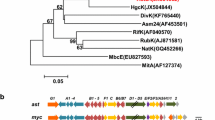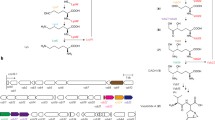Abstract
Recently, we showed that the fused chorismate-utilizing enzyme from the antibiotic-producing soil bacterium Streptomyces venezuelae is an anthranilate synthase (designated SvAS), not a 2-amino-2-deoxyisochorismate (ADIC) synthase, as was predicted based on its amino acid sequence similarity to the phenazine biosynthetic enzyme PhzE (an ADIC synthase). Here, we report the characterization of SvAS using steady-state kinetics, gel filtration chromatography, and laser light scattering. The recombinant His-tagged enzyme has Michaelis constants Km with respect to substrates chorismate and glutamine of 8.2 ± 0.2 μM and 0.84 ± 0.05 mM, respectively, and a catalytic rate constant k cat of 0.57 ± 0.02 s−1 at 30 °C. Unlike most other anthranilate synthases, SvAS does not utilize ammonia as a substrate. The enzyme is competitively but non-cooperatively inhibited by tryptophan (K i = 11.1 ± 0.1 μM) and is active as a monomer. The finding that SvAS is a monomer jibes with the variety of association modes that have been observed for anthranilate synthases from different microorganisms, and it identifies the enzyme’s minimal functional unit as a single TrpE–TrpG pair.




Similar content being viewed by others
References
Kane JF, Jensen RA (1970) The molecular aggregation of anthranilate synthase in Bacillus subtilis. Biochem Biophys Res Commun 41:328–333
Patel N, Holmes WM, Kane JF (1974) Homologous and hybrid complexes of anthranilate synthase from Bacillus species. J Bacteriol 119:220–227
Sawula RV, Crawford IP (1973) Anthranilate synthetase of Acinetobacter calcoaceticus: separation and partial characterization of subunits. J Biol Chem 248:3573–3581
Queener SW, Queener SF, Meeks JR, Gunsalus IC (1973) Anthranilate synthase from Pseudomonas putida: purification and properties of a two-component enzyme. J Biol Chem 248:151–161
Patel N, Holmes WM, Kane JF (1973) Intergeneric complementation of anthranilate synthase subunits. J Bacteriol 114:600–602
Kane JF, Holmes WM, Smiley KL, Jensen RA (1973) Rapid regulation of an anthranilate synthase aggregate by hysteresis. J Bacteriol 113:224–232
De Troch P, Dosselaere F, Keijers V, de Wilde P, Vanderleyden J (1997) Isolation and characterization of the Azospirillum brasilense trpE(G) gene, encoding anthranilate synthase. Curr Microbiol 34:27–32
Bae YM, Holmgren E, Crawford IP (1989) Rhizobium meliloti anthranilate synthase gene: cloning, sequence, and expression in Escherichia coli. J Bacteriol 171:3471–3478
Paradkar AS, Stuttard C, Vining LC (1991) Molecular cloning of the genes for anthranilate synthetase from Streptomyces venezuelae ISP 5230. FEMS Microbiol Lett 62:177–181
Baker TI, Crawford IP (1969) Anthranilate synthase: partial purification and some kinetic studies on the enzyme from Escherichia coli. J Biol Chem 241:5577–5584
Tamir H, Srinivasan PR (1969) Purification and properties of anthranilate synthase from Salmonella typhimurium. J Biol Chem 244:6507–6513
Henderson EJ, Nagano H, Zalkin H, Hwang LH (1970) The anthranilate synthetase-anthranilate 5-phosphoribosyltransferase complex of Salmonella typhimurium. Implications concerning the mode of assembly of the complex. Biochemistry 13:1416–1423
Bauerle R, Hess J, French S (1987) Anthranilate synthase-anthranilate phosphoribosyltransferase complex and subunits of Salmonella typhimurium. Methods Enzymol 142:366–386
Zalkin H, Hwang LH (1971) Anthranilate synthetase from Serratia marcescens: on the properties and relationship to the enzyme from Salmonella typhimurium. J Biol Chem 246:6899–6907
Robb F, Hutchinson MA, Belser WL (1971) Anthranilate synthetase: some physical and kinetic properties of the enzyme from Serratia marcescens. J Biol Chem 246:6908–6912
Tutino ML, Tosco A, Marino G, Sannia G (1997) Expression of Sulfolobus solfataricus trpE and trpG genes in E. coli. Biochem Biophys Res Commun 230:306–310
Byrnes WM, Vilker VL (2004) Extrinsic factors potassium chloride and glycerol induce thermostability in recombinant anthranilate synthase from Archaeoglobus fulgidus. Extremophiles 8:455–462
Morollo AA, Eck MJ (2001) Structure of the cooperative allosteric anthranilate synthase from Salmonella typhimurium. Nature Struct Biol 8:243–247
Spraggon G, Kim C, Nguyen-Huu X, Yee M-C, Yanofsky C, Mills SE (2001) The structures of anthranilate synthase of Serratia marcescens crystallized in the presence of (i) its substrates, chorismate and glutamine, and a product, glutamate, and (ii) its end-product inhibitor, l-tryptophan. Proc Natl Acad Sci USA 98:6021–6026
Knöchel T, Ivens A, Hester G, Gonzalez A, Bauerle R, Wilmanns M, Kirschner K, Jansonius JN (1999) The crystal structure of anthranilate synthase from Sulfolobus solfataricus: functional implications. Proc Natl Acad Sci USA 96:9479–9484
Zalkin H, Kling D (1968) Anthranilate synthetase. Purification and properties of component I from Salmonella typhimurium. Biochemistry 7:3566–3573
Ashenafi M, Carrington R, Collins AC, Byrnes WM (2008) The fused TrpEG from Streptomyces venezuelae is an anthranilate synthase, not a 2-amino-2-deoxyisochorismate (ADIC) synthase. Ethn Dis 18(S2):9–13
Lin C, Paradkar AS, Vining LC (1998) Regulation of an anthranilate synthase gene in Streptomyces venezuelae by a trp attenuator. Microbiol 144:1971–1980
Grisostomi C, Kast P, Pulido R, Huynh J, Hilvert D (1997) Efficient in vivo synthesis and rapid purification of chorismic acid using an engineered Escherichia coli strain. Bioorg Chem 25:297–305
Addadi L, Jaffe EK, Knowles JR (1983) Secondary tritium isotope effects as probes of the enzymic and nonenzymic conversion of chorismate to prephenate. Biochemistry 22:4494–4501
Caligiuri MG, Bauerle R (1991) Subunit communication in the anthranilate synthase complex from Salmonella typhimurium. Science 252:1845–1848
Li QA, Mavrodi DV, Thomashow LS, Roessle M, Blankenfeldt W (2011) Ligand binding induces an ammonia channel in 2-amino-2-desoxyisochorismate (ADIC) synthase PhzE. J Biol Chem 286:18213–18221
Ziebart KT, Dixon SM, Avila B, El-Badri MH, Guggenheim KG, Kurth MJ, Toney MD (2010) Targeting multiple chorismate-utilizing enzymes with a single inhibitor: validation of a three-stage design. J Med Chem 53:3718–3729
Acknowledgments
We acknowledge support from the U. S. National Institutes of Health (NIH) RCMI (Grant number 2G12RR003048-18) and MBRS-SCORE programs (Grants number 3S06GM0816-33S1 and 1SC3GM083752) to WMB. We thank Tin-Wein Yu, formerly of the University of Washington, for assistance with the development of protocols for expression of SvAS, Santiago Ramon-Maiques of the Centro Nacional de Investigaciones Oncológicas in Madrid for helpful discussions about the structure of the enzyme, and Michael J. Eck of Harvard University for providing us with the high resolution images used in Fig. 4. Disclaimer: certain commercial equipment, instruments, and materials are identified in this paper in order to specify the experimental procedure as completely as possible. In no case does such identification imply a recommendation or endorsement by the National Institute of Standards and Technology, nor does it imply that the material, instrument, or equipment identified is necessarily the best available for the purpose.
Author information
Authors and Affiliations
Corresponding author
Rights and permissions
About this article
Cite this article
Ashenafi, M., Reddy, P.T., Parsons, J.F. et al. The fused anthranilate synthase from Streptomyces venezuelae functions as a monomer. Mol Cell Biochem 400, 9–15 (2015). https://doi.org/10.1007/s11010-014-2256-3
Received:
Accepted:
Published:
Issue Date:
DOI: https://doi.org/10.1007/s11010-014-2256-3




